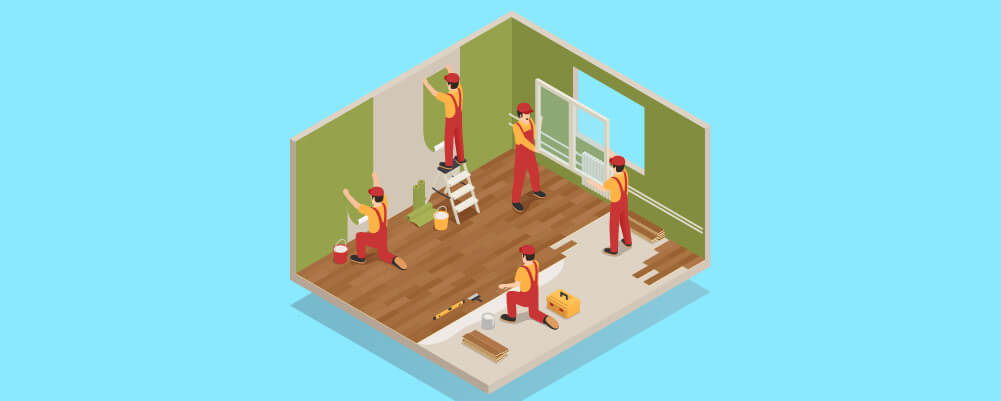
Introduction
Renovating your house can be daunting, especially if you haven’t done it before. There is a lot of planning, preparation, and specialized equipment needed to properly remodel a home, so you need to know what you’re doing beforehand.

That’s where this guide comes in. With our ultimate guide to renovating your house, you’ll learn all about how to bring your home remodeling ideas into reality. We have tackled the process step-by-step, so it should be easy to follow no matter your construction and DIY skills.
You’ll also notice that we have provided references to other reading materials. These offer more insight into some of the home renovation topics included here or explore related subjects that aren’t covered in the scope of this guide.
With that understood, let’s get started.
Remodeling A House: Getting Started

To get started, we need a plan.
We have split this guide into multiple sections that each cover something different about home renovation. This allows us to cover the topic in the detail it deserves while still covering the entire process. Maybe you’ve already done a little renovation or your plans aren’t that extensive, in which case you can easily find the sections that are relevant to you.
This guide is split into three parts:
- Remodeling A House: Getting Started
- Planning A Home Remodeling Project
- Home Remodeling: Step By Step
Between these three parts, you’ll first learn about the practical realities of owning a home and identifying when your home is an ideal renovation candidate.
From there, we have a short guide on planning for your remodeling project, which includes budgeting so that your project never runs out of money.
Last but certainly not least, we then have a step-by-step guide on implementing your desired changes and adding any final touches.
Why Are You Remodeling?
Before you settle on any plans, you should know why you are remodeling your home. Renovations can eat up a lot of your time and money, so you should have good reasons for committing to a remodeling project.
You probably have an idea already. If not, everybody will typically fall in one of these categories:
- You are running maintenance on your home.
- You are improving the efficiency of your home.
- You are changing the style of your home.
- You are updating rooms within your home.
- You are looking to sell your home.
Every home needs maintenance sometimes, no matter how young or old it is. The electrical and plumbing systems of your house won’t last forever, which is why maintenance is important. Maintenance typically requires hired professionals who know more about electronics/waterworks than you do.
Speaking of the electric and plumbing systems in your home, they can be more costly to run when they are outdated. That’s why some renovation jobs focus on updating them, bringing utility bills down, and installing modern tech like solar paneling or smart thermostats.
Sometimes, you want to change how your house looks because it is outdated, or simply just because you want to. This is common for those who have lived in the home for decades, where style trends have come and gone. Updating individual rooms, most commonly kitchens and bathrooms, are also a focal point for many renovation projects.
Lastly, a renovated home looks better and is more comfortable to live in. This means sellers can opt for a higher asking price when putting their homes on the market. Just a little bit of TLC can make a home sale much more profitable, so it’s often worth the effort on behalf of the homeowner.
Planning A Home Remodeling Project

By answering that question, you should now have some idea of what your remodeling project will look like. You may have come here with a plan already; in which case this part is going to be easy.
We can create an effective remodeling plan as long as we keep these four things in mind:
- The size and scope of the project.
- How extensive the remodeling is.
- The budget for this project.
- How time is allocated to work on the project.
Let’s explore each of those in some more detail.
Assess The Size & Scope Of Your Remodel
You need to know how big this remodel is going to be before you commit to anything. In this case, knowing ‘how big’ means you should know the specific areas that are going to be affected and their size, as detailed on your home’s blueprints or house floor plans, in centimeters and meters.
You don’t want to eyeball your home and hope your mind is accurate enough to fill in the unknowns. If you can’t read blueprints, learn how to do it or find somebody like an architect that can do it for you… for a price, of course.
If you underestimate the size of your project, you won’t have enough materials/manpower and then you’ll waste valuable time waiting for more resources to make themselves available. If you overestimate, you’ll spend more than you should on resources only to get a disappointing result.
When looking at which rooms will be affected, you should remember that not all rooms are made equal. Remodeling a bathroom or a kitchen will cost much more than changing an empty guest room, for example. Even the difference between removing a standard and load-bearing wall can be thousands of dollars. How will you know which walls are load-bearing? The house floor plans should have everything you need.
Larger projects will also take more time. If you’re still living on the premises, you can also expect that time to increase since you’ll be getting in the way and work will have to be suspended for you to live your life.
Will It Need Extensive Remodeling?
Let’s stop for a moment and address any concerns that may come with a larger remodeling project.
If your planned remodeling is a larger, longer, costlier project then you’ll want to know everything you can before you start. The larger the project is, the more benefit you’ll get from carefully planning your approach.
First, what should you consider when tackling a larger project?
Well, is it possible? You can’t just change large swathes of your home without thinking of unintended consequences. You should find a contractor who offers building surveyance and assessment services. They’ll come in and figure out how strong your home is if your home can take the planned changes and give you an estimate of how much those changes will cost.
This allows you to be realistic about your project’s ambitions. It also gives you some numbers to work with when you’re figuring out the budget, which we have a section covering below.
You should also consider the age of your home. Does it have unique features that you want to preserve? Do the plumbing and electrics need updating? Those procedures are expensive and should be left to professionals most of the time. It may cost money but it’s better than accidentally sabotaging your home’s power supply.
Remember that a large project is a lot of work for one person.
As we have already mentioned, your larger project will probably require a permit too. In fact, any alterations made to the electric or plumbing services to your home may require a qualified contractor to sign off on them. That means they come to your home, check out your handiwork, then put their name forward to vouch that it meets the required standards.
By paying them a little extra, these professionals will just do the work for you and they’ll probably do a better job, so that’s something to consider. Here are some of the advantages and disadvantages of DIY versus hiring professionals:
| DIY Pros | Hiring Professionals Pros |
| Can save on labor expenses if you can do the work yourself. | They are professionals who are educated, qualified and have the required equipment. |
| Can be satisfying and a point of pride for many homeowners. | Many pros come with insurance and customer protection schemes. |
| DIY Cons | Hiring Professionals Cons |
| You need to know what you’re doing. | Professionals don’t come cheap. |
| You may damage your property and cause more issues. | Their skill level and construction specializations differ. |
| You can physically harm yourself or others on the premises. | You should verify they are qualified and have a good reputation among former customers. |
Establish Your Budget
Next, start thinking about how much money you’re going to spend. Without enough funds, your project isn’t going to get finished. Even worse, your home will be left a mess, so you won’t be able to live in it normally until you gather the finances needed to get the job done.
Along with the size of your project and the rooms that are being worked on, the budget is the third determining factor in how large the project is and how long it will take. If you have a big budget to work with, your home renovation dreams will be more achievable.
Your budget should be sourced from somewhere responsible. You shouldn’t pour your monthly paycheck into ongoing home renovation plans, you’ll want to build up some cash inside a savings account instead. You can also get a loan from a bank or a credit union, as long as they are legitimate institutions that offer loans favorable to you and your financial situation.
Once you have a set budget and work is ready to begin, there are things you can do to keep costs down.
Create A Schedule
To control how long your remodeling project will take, you’ll need to create a schedule. If you are doing minor remodeling, so you’re doing most of the work, then you’ll need a schedule to organize your work. If you have a larger project involving contractors, you’ll need a schedule so that everybody knows when they are working, so they don’t clash with one another.
The exact schedule your home needs will depend on your building and the remodeling you have planned. Planning a schedule with a building inspector or a similarly qualified individual will help a lot, and schedules typically work from inside out. Here’s a rough order that most home remodeling schedules follow:
- Seeking out the required permissions and resources to undertake the job.
- Demolition and other drastic measures altering the footprint of your home.
- Solving fundamental problems with the structure, such as piping or wiring issues, or damp if any is present.
- Relatively superficial redecoration and renovation of interior spaces.
- Exterior work with plastering and landscaping.
Home Remodeling: Step By Step

Now you should know enough to understand our step-by-step guide to home remodeling. Below we have twelve steps that you’ll find in most remodeling or renovation projects, though some of them will only be a part of larger plans. Take demolition as an example, you’re probably not demolishing anything if you’re making superficial changes to your home.
That said, you should find something useful below for anybody that has home renovation/remodeling planned. Knowing about the process before you start will take a lot of stress off of your shoulders, too.
Start With The Design
First, you need to start with a design. You can’t work blind for most things, so you definitely shouldn’t go in blind when it comes to remodeling your home. You’ll also need to know what you want before you start.
Your project should have an objective, which will be tied to why you’re doing these renovations in the first place. If you want to improve the market price of the home then that’s your objective. If you want to make the exterior of your home look a certain way, then your objective is more based on personal tastes.
Make a list of nice-to-haves and then your objectives, which are must-haves for your project to be successful. Use a floor plan or a blueprint so you have your property’s footprint arrangement, by the numbers. For large, extensive projects, you’ll find that a lot of your nice-to-haves won’t be compatible with your home unless you’re demolishing the place and starting over.
With your project objectives in mind, you’ll then need to get a design for what those objectives will look like in your home. Designs should be run by an architect and structural engineer to make sure that they are accurate and won’t compromise the structural integrity of the building. You don’t want to bore through a load-bearing wall without counteracting its removal, for instance.
When looking for a design, you should consult somebody who has credentials. This can be an architect, sure, but that’s not your only option. There are design and build companies that can help and often cost less than a dedicated architectural specialist, though sometimes you get what you pay for.
Nothing is stopping you from drawing up designs yourself if you have the skills and the know-how. Some even use 3D-modeling programs to create accurate designs.
Source Your Materials
Something we’ve neglected to mention so far is the material cost of your remodeling project. Sure, we’ve talked about having a budget and sourcing finances for the project, but what is that money spent on? One word – materials.
To take apart, rebuild, and add new parts to your home, you’ll need to have the correct materials in the right quantities.
What will you need?
- Paint, of the required brands, types, and colors.
- Wall and floor coverings.
- Furniture, if you’re replacing any.
- Storage cabinets, if needed.
- Appliances, if electrical or kitchen appliances are being replaced.
- Equipment needed to facilitate renovation/remodeling.
Budget will be a big determining factor in the materials you can get. More money will give you access to higher-quality materials, and more of them. You don’t need to break the bank – it makes more sense to only use high-end materials in rooms that you’ll frequent more than others.
Request Permits If Necessary
In many places, you may need a permit or some other go-ahead from local authorities, even if you’re the owner of the home. Local building departments need to make sure that buildings in their jurisdiction meet current building codes and requirements, for the safety of everybody involved. If everybody is remodeling their homes, the quality of the results will vary depending on the scope of the project and the skill of the people carrying out the work.
The requirements for a permit can change between counties or even cities, so you’ll need to be aware of your local rules regarding home construction and renovation. Call a local inspector or a business that works in home remodeling to ask if your city/county/state requires notification of your remodeling efforts.
Submitting a permit typically follows these steps:
- Fill out the necessary paperwork.
- Acquire blueprints (only for very large projects) and have them co-signed by a building inspector.
- Pay the fee that is often attached to permit applications.
- Send the permit – note that many can be completed online nowadays.
- Schedule inspections with your local building inspector throughout construction.
You should keep this general rule in mind – if it changes the footprint of your home, you may need a permit.
This isn’t true for everywhere, naturally, but creating a new door into the home may require a permit while replacing an existing door should not. Repainting a ceiling won’t require a permit but, if you want to make a big hole in that ceiling for a skylight, you may need to run that by your local building inspector. This doesn’t just apply to construction; hefty demolition jobs may need a permit too.
Start Demolition
That brings us to our first optional step – demolition. If your project is a couple of room redecorations and a new plumbing system, you don’t need to bomb the old ones to do it right.
For more extensive projects, however, you may need to start from scratch. Demolition allows us to safely clear an area so that something else can be built there. While you may be able to draw your own designs and build your own furniture, you’re not a demolition expert. Instead, you’re likely to throw a sledgehammer through some wiring or piping by accident. Consult with a contractor that is certified to work with explosives and other means of controlled demolition.
While it may be a dramatic and sometimes explosive part of home renovation, demolition shouldn’t be too expensive in the grand scheme of things. You can also keep costs down by recycling whatever you can, wherever you can. Naturally, areas being demolished should be picked clean of any equipment and materials that can be used elsewhere.
Tackle Structural Changes First
You can’t change the structure of your home without interfering with redecorations and other simple procedures, so you should start there. This is where you’ll establish your working space and address any change that needs to be made there, such as a change in the foundation or changing electric or plumbing systems (which we have elaborated on below.)
Maybe you discover that your home has damp or subsidence, issues that will need to be solved sooner rather than later. The earlier those kinds of problems are identified and rectified, the less damaging and costly they will be to your home and your remodeling ambitions. Getting rid of damp may require help from an expert who knows how to get rid of it and keep it out.
Electrical & Plumbing Tasks
Once again, this is where you should tag somebody in to help you install or change your home’s wiring or piping. If you aren’t a qualified plumber or electrician, you should get a professional who knows what they are doing. Even if you do know what you are doing, getting a second pair of eyes on your handiwork is ideal and often necessary if permits need to be signed.
Every room should have wiring and, if a room needs to have special lighting that’s more waterproof or makes use of non-standard light colors, now is the time to bring that up. If a room doesn’t have electrical outlets, more will need to be installed. Home rewiring can get expensive but it’s also a great investment in terms of home resale/value.
While electricity and plumbing are basic requirements for your home, you should also take them as an opportunity to tailor your home to your liking. You can change the wiring or piping of your house to cater to your lifestyle, like making the necessary amendments to install a hot tub.
Upgrading Windows
Here’s a fun fact – the windows in your home are probably outdated. Once installed, and assuming that they don’t develop mold or let water in, our windows tend to go ignored as long as they let the sunshine in.
Your home remodeling or redecoration project can be the perfect opportunity to replace or upgrade your windows. The methods and techniques that we use to create windows changes all the time. Perhaps the biggest and best example is double-glazing, where two panes of glass tend to work better than one. Yet still, many windows just have one pane of glass.
Windows aren’t just for letting the light in or prying on your neighbor’s businesses, they also manage the heat distribution throughout your home. That’s why we have many different types of windows with different properties relating to insulation, weather resistance, and illumination. The material used around the panes of glass is important too, especially depending on how hot/cold and humid your local climate is.
Here are some of the windows, frames, and glass types you can install during your home remodeling project:
- Casement Window – A window that opens on hinges attached to its frame.
- Sliding Window – A window where the frame, with the glass, slides to the side to open and close. These are popular with sliding doors.
- Skylight – A window that’s part of the roofline, or just above it, installed in the ceiling.
- Wooden Frames – Look great but can require more maintenance depending on where you live.
- Metal Frames – Made from steel or aluminum, these will last long and can be recycled in the future. Metal is also resistant to rot, unlike wood.
- Composite Frames – A mix of wood and metal with some plastic, which is low maintenance and can handle harsh weather. Metal and plastic are resistant to rot, too.
- Float Glass – These are the standard panes of glass used, where they are smooth and thin. There is also tempered glass, which has been treated to be much stronger.
- Obscured Glass – This is semi-transparent or opaque glass for privacy purposes, like the kind that is used for bathrooms.
- Laminated Glass – Glass mixed with PVB, EVA, TPU, or resin so that it is strong and won’t violently shatter when broken.
- Tinted Glass – Glass that is tinted or colored for privacy or aesthetic purposes. They’re also great at deflecting UV rays.
Improve Insulation
Having mentioned insulation and the role windows play, your remodeling project may be an opportunity to reinforce your home against the weather. Insulating your home is a great way to reduce energy costs since you won’t rely on heating or an AC system to warm or cool your house.
If your project involves working on the walls of your home, you should add or upgrade the insulation there. It may be an extra cost but once the insulation is installed and out of sight, you won’t have to worry about it anymore, and it’ll keep saving you money long into the future. If you are prone to irritation, you can get special insulation that won’t cause breathing issues.
Complete Interior Painting

Even the least intrusive, mildest redecoration projects involve a fresh coat of paint. Whether you’ve remade an entire room or you’re just touching up the back wall, you’re going to need some paint. Unlike many of the jobs we’ve mentioned already, you can also do this part yourself!
Neutral colors are ideal for interior walls, though the color and style of paint will depend on your décor and the rooms that you’re working on. Bedrooms, for example, tend to have more colorful, adventurous, and personally expressive color schemes. Any paint used in bathrooms will need to be waterproof, too.
If you don’t want to redecorate often, you’ll need to keep your interior paint style muted so that it’s compatible with future decoration changes. Your furniture, if you are getting any, should be compatible with the paint you are choosing.
Install Flooring
Along with painting or covering the walls, you’ll need to install flooring in any rooms that have been stripped during your remodeling project. There are four main floor types for a domestic area – carpet, laminate, wood, and tiles.
Each comes with its own advantages and disadvantages. Tiles, for example, are great for kitchens and bathrooms but they can be an eyesore anywhere else. They’re hardy and easy to clean. Tiles can get cold, so they’re not great for keeping a room warm and insulated. Flagstones are similar but tend to look better in areas that are outdoors or lead outdoors.
Carpeting will be soft and comfortable but it can gather dust and it will get a stain or two in the foreseeable future. It also provides passive insulation to the room. They can be cleaned, sure, but that’s extra maintenance that some people don’t want to deal with.
Wood isn’t generally as hard as tile, though that depends on if you’re getting softwood or hardwood flooring. Wood flooring is also versatile, compatible with most styles, and can also be cleaned effectively. Most wood flooring needs to be acclimatized to the property, otherwise, it can expand or contract with temperature changes and cause damage to the room. Wood can also be quite loud when walked across, which can become especially disruptive if you have pets.
In a larger-scale project, lay the flooring edge to edge before you fill the space with furniture and other obstacles that would get in the way. Then you are free to bring in the superficial elements of your interior redecoration by adding new fixtures and returning any removable objects that were taken from the premises at the start of your project.
House Exterior
With the interior complete, the next step is typically the exterior. Most remodeling and decorating projects are focused on the interior, others focus solely on the exterior, while larger projects might need to work on both. No matter the scope of your project, remodeling the exterior of your house is much more noticeable and appreciated than anything you do inside.
Most people will only see your house by its exterior, so most exterior remodeling projects focus on how the home looks from the curb. If your house has been neglected or is a fixer-upper, then upgrading the exterior is one of the biggest things you can do to drive the sale price up. We call it curb appeal for a reason.
So, what can you do?
- You can change the color or texture of the front door or change the door entirely.
- You can change the finish of cladding and rendering, and make use of PVC paneling, wooden paneling, or brick tiles to do it.
- You can replace the guttering system.
- You can replace the roof surface or give it a new color.
- You can add a porch, patio, or lawn to the front.
- You can convert an unused garage into an outdoor recreational area.
- You can add or change the mailbox outside of the property.
Landscaping
Lastly, having mentioned lawns, you may want to consider landscaping. This isn’t part of every project but, if you have green fingers or you know somebody who does, then this can make your home look even better from the outside. You can add plants that look good and go above and beyond the curb appeal of a lawn. Plants that flower and bear exotic, appealing colors are best.
If you want something more practical, you can also grow plants that bear fruit and vegetables. They’d need to be sustainable in the local area, and they’ll take maintenance, but many people enjoy eating foods that they have sourced themselves.
Summary

That brings us to the end of our guide on remodeling and redecorating your home. You should now have an idea of where to start and how to plan, prepare for, and carry out a home remodeling project. We don’t know the specifics of your plan but, with the steps we have provided, you should have some structure to work from.
Our step-by-step guide has covered the fundamentals that are involved with every project, moving from the basic structural concerns of your house to the optional finishing touches that can be added to the exterior. By following them all, you can make your home a better place to live while also increasing its value dramatically.






